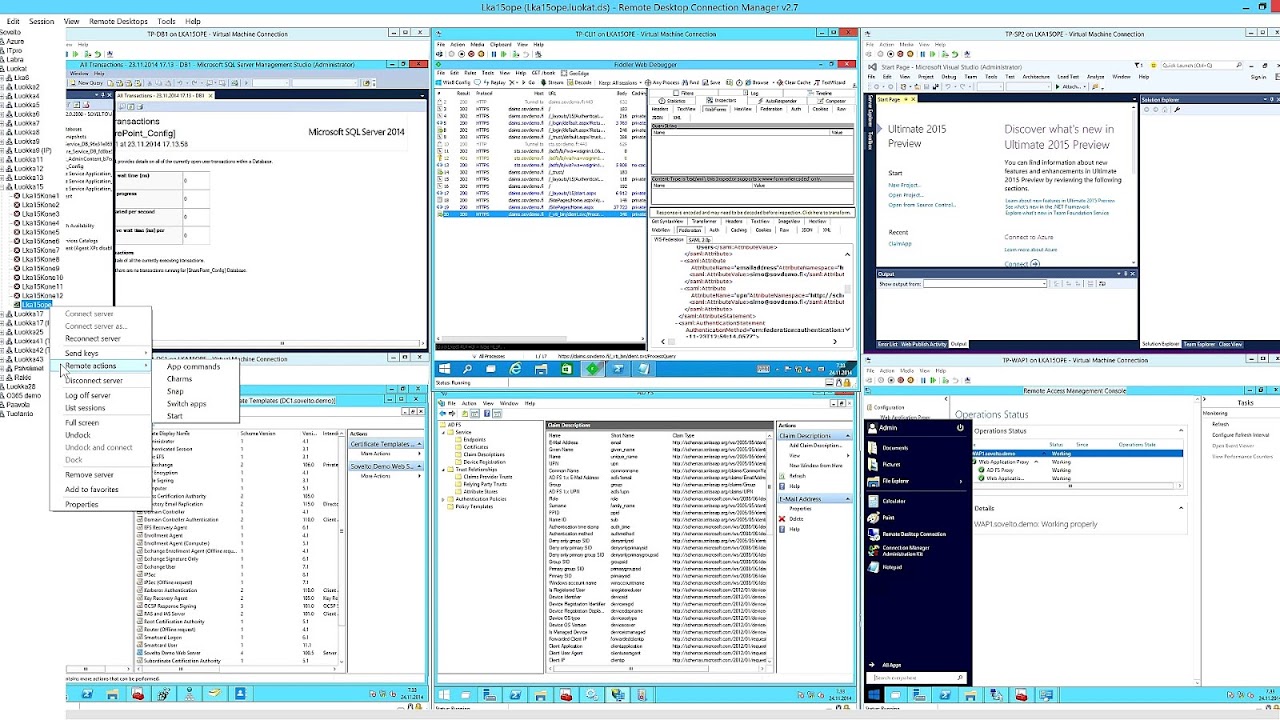Update your remote administration clients automatically. IIS Manager for Remote Administration ensures that users are automatically informed of new features added to the remote IIS Web server so that they can download the necessary updates locally to manage those features. Remotely manages IIS from Windows clients (XP and above). Microsoft SQL Server 2014 Express is a powerful and reliable free data management system that delivers a rich and reliable data store for lightweight Web Sites and desktop applications. Remote Desktop Connection Manager 2.7. RDCMan manages multiple remote desktop connections. To enable remote control and configure client settings In the Configuration Manager console, choose Administration Client Settings Default Client Settings. On the Home tab, in the Properties group, choose Properties. In the Default dialog box, choose Remote Tools.
Microsoft Remote Manager Power Cycle
- Changes to Remote Connection Manager in Windows Server 2016.; 3 minutes to read; D; h; s; In this article. This article describes Remote Connection Manager (RCM) and the changes to RCM in Microsoft Windows Server 2016.
- To use Remote Assistance or Remote Desktop, it must be installed and configured on the computer that runs the Configuration Manager console. For more information about how to install and configure Remote Assistance or Remote Desktop, see your Windows documentation. To enable remote control and configure client settings.
Install this extension or view additional downloads

Microsoft
Overview
Internet Information Services (IIS) Manager for Remote Administration provides end users and administrators with the ability to securely manage remote IIS servers (version 7 and above) from Windows clients (XP and above). A Web server administrator can perform almost all IIS administrative tasks while site owners and developers that have been delegated administrative privileges can use IIS Manager for Remote Administration to make allowed changes to the remote Web server. IIS Manager for Remote offers the same user interface available on Windows Server to ensure a more consistent experience when managing and configuring the Web server.Manage remote IIS servers more securely
IIS Manager for Remote Administration allows users to more securely manage remote Web sites and applications on IIS servers over a firewall-friendly connection using HTTP over SSL.
Administer local and remote Web servers through a consistent interface
IIS Manager for Remote Administration allows you to manage Web server features and individual sites through the same, familiar user interface as IIS Manager on Windows Server.
Update your remote administration clients automatically
IIS Manager for Remote Administration ensures that users are automatically informed of new features added to the remote IIS Web server so that they can download the necessary updates locally to manage those features.
Features
- Remotely manages IIS from Windows clients (XP and above)
- Connects directly to a Web server, Web site, or Web application
- Installs even when you don't have IIS on the local machine
- Allows multiple simultaneous connections
- Supports delegated administration to Web sites and Web applications so owners can connect to and manage their own site directly
- Familiar and easy to use administration tool
- Supports HTTP over SSL for more secure management
- Automatically downloads features to the local IIS Manager for Remote Administration console to match features newly installed on the remote Web server.
Download IIS Manager for Remote Administration 1.0
- English: Web Platform Installer (WebPI) / x86 installer / x64 installer
- French: Web Platform Installer (WebPI) / x86 installer / x64 installer
- German: Web Platform Installer (WebPI) / x86 installer / x64 installer
- Japanese: Web Platform Installer (WebPI) / x86 installer / x64 installer
- Spanish: Web Platform Installer (WebPI) / x86 installer / x64 installer
Applies to: Configuration Manager (current branch)
Configuration Manager allows you to connect to client computers using Configuration Manager Remote Control. Before you begin to use remote control, ensure that you review the information in the following articles:
Here are three ways to start the remote control viewer:
In the Configuration Manager console.
In a Windows command prompt.
From the Windows Start menu, on a computer that runs the Configuration Manager console, in the Microsoft Endpoint Manager program group.
Note
The above Start menu path is for versions from November 2019 (version 1910) or later. In earlier versions, the folder name is Microsoft System Center.
To remotely administer a client computer from the Configuration Manager console
In the Configuration Manager console, choose Assets and Compliance > Devices or Device Collections.
Select the computer that you want to remotely administer and then, in the Home tab, in the Device group, choose Start > Remote Control.
Important
If the client setting Prompt user for Remote Control permission is set to True, the connection does not initiate until the user at the remote computer agrees to the remote control prompt. For more information, see Configuring remote control.
After the Configuration Manager Remote Control window opens, you can remotely administer the client computer. Use the following options to configure the connection.
Note
If the computer that you connect to has multiple monitors, the display from all the monitors is shown in the remote control window.
File
- Connect - Connect to another computer. This option is unavailable when a remote control session is active.
- Disconnect - Disconnects the active remote control session but doesn't close the Configuration Manager Remote Control window.
- Exit - Disconnects the active remote control session and closes the Configuration Manager Remote Control window.
Note
When you disconnect a remote control session, the contents of the Windows Clipboard on the computer that you are viewing is deleted.
View
- Color depth - Choose either 16 bits or 32 bits per pixel.
- Full Screen - Maximizes the Configuration Manager Remote Control window. To exit full screen mode, press Ctrl+Alt+Break.
- Optimize for low bandwidth connection - Choose this option if the connection is low bandwidth.
- Display:
- All Screens - If the computer that you connect to has multiple monitors, the display from all the monitors is shown in the remote control window.
- First Screen - The first screen is at the top and far left as shown in Windows display settings. You can't select a specific screen. When you switch the configuration of the viewer, reconnect the remote session. The viewer saves your preference for future connections.
- Scale to Fit - Scales the display of the remote computer to fit the size of the Configuration Manager Remote Control window.
- Status Bar - Toggles the display of the Configuration Manager Remote Control window status bar.
Note
The viewer saves your preference for future connections.
Action
- Send Ctrl+Alt+Del Key - Sends a Ctrl+Alt+Del key combination to the remote computer.
- Enable Clipboard Sharing - Lets you copy and paste items to and from the remote computer. If you change this value, you must restart the remote control session for the change to take effect.
- If you don't want clipboard sharing to be enabled in the Configuration Manager console, on the computer running the console, set the value of the registry key HKEY_CURRENT_USERSoftwareMicrosoftConfigMgr10Remote ControlClipboard Sharing to 0.
- Enable Keyboard Translation - Translates the keyboard layout of the computer running the console to the connected device's layout.
- Lock Remote Keyboard and Mouse - Locks the remote keyboard and mouse to prevent the user from operating the remote computer.
Help
- About Remote Control - Displays the current version of the viewer.
Users at the remote computer can view more information about the remote control session when they click the Configuration Manager Remote Control icon. The icon is in the Windows notification area or the icon on the remote control session bar.
To start the remote control viewer from the Windows command line
- At the Windows command prompt, type <Configuration Manager Installation Folder>AdminConsoleBini386CmRcViewer.exe
CmRcViewer.exe supports the following command-line options:
Address- Specifies the NetBIOS name, the fully qualified domain name (FQDN), or the IP address of the client computer that you want to connect to.Site Server Name- Specifies the name of the Configuration Manager site server to which you want to send status messages that are related to the remote control session./?- Displays the command-line options for the remote control viewer.

Remote Access Connection Manager Windows 10
Example:CmRcViewer.exe <Address> <Site Server Name>
Note
Microsoft Remote Management Tools

The remote control viewer is supported on all operating systems that are supported for the Configuration Manager console. For more information, see Supported configurations for Configuration Manager consoles and Prerequisites for remote control.
Next steps




